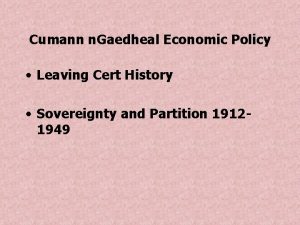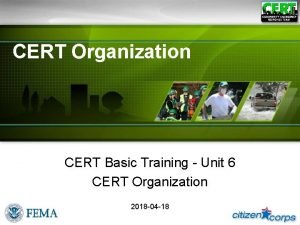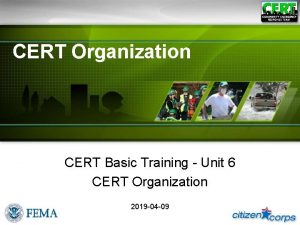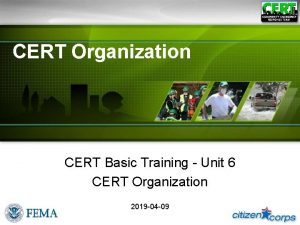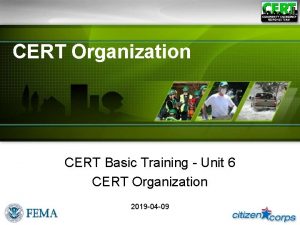Cumann n Gaedheal Economic Policy Leaving Cert History












- Slides: 12

Cumann n. Gaedheal Economic Policy • Leaving Cert History • Sovereignty and Partition 19121949

Cumann n. Gaedheal Economic Policy • Background • Political considerations • Agriculture • Industry • Specific Economic Measures • Impact of Economic Policies

Background • Cumann na n. Gaedhael inherited a backward economy, burdened by Civil War debts and an overwhelming depression in agriculture. • Economic realities included: - Realisation that the Irish economy was enmeshed with the British economy. - Few cabinet members had economic experience. - The world economy was in recession. - Ireland was a predominant rural economy and the major industrial area had been partitioned off.

Political considerations • Generate support for the new State and confidence among certain crucial classes - the bankers, the large farmers and the Anglo-Irish community. • Government adopted a conservative policy - Concentrated on agriculture (2/3 of the population lived in rural areas and half the workforce were employed in agriculture). - There was a belief that industrialisation could not be engineered. - Maintained the link with Sterling which left the Irish pound over-valued - which avoided problems with inflation in the 1920 s. - The government needed to avoid bankruptcy - adopted a policy of low taxation, avoidance of borrowing and balancing the budget.

Agriculture – The Problems • Small farms who had no money for new technology. • Conservative and old farmers who did not relinquish their farms to theirs until they were relatively old, cautious and conservative. • Ireland had supplied poor quality produce to England during the war so her reputation for quality was poor. • Britain adopted a cheap food policy in postwar period • This meant that prices obtained for Irish produce declined.

Agriculture – The Policies • Minister for Agriculture, Patrick Hogan • Set standards for production of butter, meat and eggs. • Advisory service to improve breeding stocks and crops. • Interventionist policy to improve standards in marketing. • Established the Agricultural Credit Corporation to make loans - few took advantage of it. • The 1923 Land Act completed the compulsory purchase of all land still held by landlords - but many farms were too small to be viable. • Income tax was kept low, cut from 25% to 15% between 1924 - 26.

Agriculture – The Outcomes • Limited success in the early years. • Little change in volume of output or the structure of exports. • Value of butter exports rose very slowly. • The number of cows actually fell a little. • The total value of exports reached a peak in 1924 at £ 51. 6 m, fell to £ 42 m in 1926, recovered to £ 48 m in 1929 and did not reach that figure again until 1948. • Loss of tillage and a new dependence on imported foodstuffs. • Development of sugar beet as new cash crop - this was the exception. • Policies benefited the strong farmers, rather than the smaller ones.

Industry – The Problems • Not a priority for Government. • Home market was too small to cope with imports. • No source of power. • The government was convinced it was unlikely that industry would emerge without the help of protectionism, bounties or special financial provision. • Larger industries opposed protectionism • The exception was the Shannon Scheme at Ardnacrusha and the establishment of the 'semi-state company', the ESB.

Specific Economic Measures • Cut wages of teachers, gardai and civil servants by 10% in 1923. • Cut in Old Age Pension by 10% in 1924. • Government used the building of the Ardnacrusha Shannon Scheme to drive down wages by up to 30%, provoking a nine month long strike in Limerick involving hundreds of workers.

Impact of Economic Policies • Economic growth was slow. • Unemployment never fell below 6% and could have been much higher than this official figure (perhaps 17% in 1926) • Was deemed to be due to laziness of workers or restrictive trade union practices. • Emigration averaged 33, 000 each year. • Income tax remained low, which meant that it was difficult to tackle intractable poverty and social problems.

• Presentation prepared by: • • Dominic Haugh St. Particks Comprehensive School Shannon Co. Clare • Presentation can be used for educational purposes only – all rights remain with author

 History syllabus leaving cert
History syllabus leaving cert Dominic haugh leaving cert history
Dominic haugh leaving cert history Leaving cert history topics
Leaving cert history topics Maud gonne biography
Maud gonne biography English paper 2 timing
English paper 2 timing Regional geography leaving cert
Regional geography leaving cert Construction studies portfolio example
Construction studies portfolio example Nitrogen cycle diagram leaving cert
Nitrogen cycle diagram leaving cert Marble and slate
Marble and slate Lcpe pa
Lcpe pa Music technology leaving cert
Music technology leaving cert Bishop poetry leaving cert
Bishop poetry leaving cert Elizabeth bishop themes
Elizabeth bishop themes

